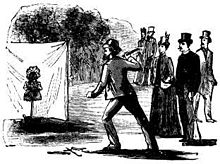Aunt Sally

Aunt Sally is a traditional English game in which players throw sticks or battens at a model of an old woman's head. It was usually played in pub gardens and fairgrounds. The game is still played today, mainly in Oxfordshire and some bordering counties. It is played in leagues by pub teams throughout the spring and summer months, in teams of 8.
Origin of the term
It has been suggested that the term was based on a blackface doll itself inspired by a low-life character named "Black Sal", which appeared in an 1821 series of novellas entitled Life of London by Pierce Egan, a contemporary of Charles Dickens.[1]
The game
The game was traditionally played in central English pubs and fairgrounds. An Aunt Sally was originally the modelled head of an old woman with a clay pipe in her mouth, or later a ball on a stick.
There are also other theories of how the game started; one such theory is that a live chicken was placed on the stick, and people would throw sticks at it. Whoever killed it won the game and took home the chicken. Another theory is that in Port Meadow in Oxfordshire, at the time of the English Civil War, the Cavaliers (soldiers loyal to King Charles I) were bored and formed a game with sticks and makeshift materials similar to the game as understood today. The object was for players to throw sticks at the head in order to break the pipe. The game bears some resemblance to a coconut shy or skittles.
Today, the game of Aunt Sally is still played as a pub game in Berkshire, Buckinghamshire, Gloucestershire, Oxfordshire, Northamptonshire[2] and Warwickshire. The ball is on a short plinth about 10 cm high and is known as a "dolly". The dolly is placed on a dog-legged metal spike a metre high, and players throw sticks or short battens at the dolly, trying to knock it off without hitting the spike. Successfully hitting the dolly off is known as a "doll"; however if the spike is hit first, then the score does not count and is called an "iron". [citation needed]
Cultural references
In literature
- G.K. Chesterton, in his ironically-titled anti-German book The Crimes of England (1915), refers to the wooden likeness of Paul von Hindenburg (described above) as a "wooden Aunt Sally"
In television
- Aunt Sally also featured on the BBC Countryfile programme in August 2013
- In the season 1 premiere episode of the UK TV series House of Cards (1990), journalist Mattie Storin - in her first conversation with the Chief Whip, Francis Urquhart - confirms she understands Francis' explanation of how newly elected Prime Minister Henry Collingridge is being used as a pawn and set up to take a fall by calling the PM an Aunt Sally
- Aunt Sally is played in the British detective television series Midsomer Murders, episode 18, "Dark Autumn"
- Aunt Sally appears as a character, portrayed by Una Stubbs, in the television adaptation of the children's serial Worzel Gummidge, produced by Southern Television for ITV from 1979 to 1981; she is a fairground doll of the type used as a target for throwing competitions but nevertheless considers herself to be of a superior class to Worzel, a scarecrow, and her frustrated suitor
See also
- Pub games
- British folk sports
- PEMDAS (Please Excuse My Dear Aunt Sally), the order of mathematical operations
- Scapegoat
- Straw man
- The Adventures of Huckleberry Finn (1884) by Mark Twain, in which Aunt Sally is a character who attempts to adopt and "sivilize" Huck
- Whipping boy
References
This article includes a list of general references, but it lacks sufficient corresponding inline citations. (March 2013) |
- ^ "Aunt Sally". Worldwide Words. Retrieved 13 June 2014.
- ^ http://www.banburyguardian.co.uk/sport/aunt-sally-1-591325
External links
Chisholm, Hugh, ed. (1911). . Encyclopædia Britannica. Vol. 2 (11th ed.). Cambridge University Press. p. 922.
